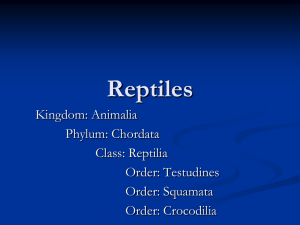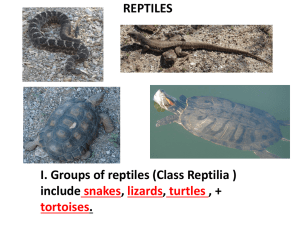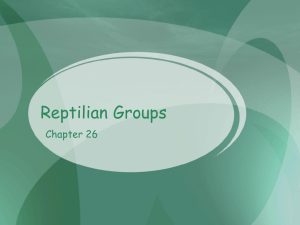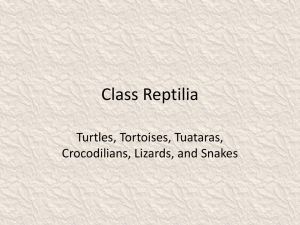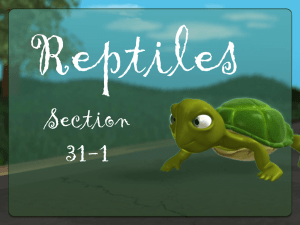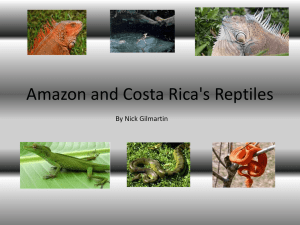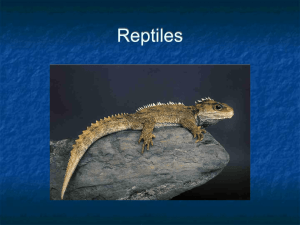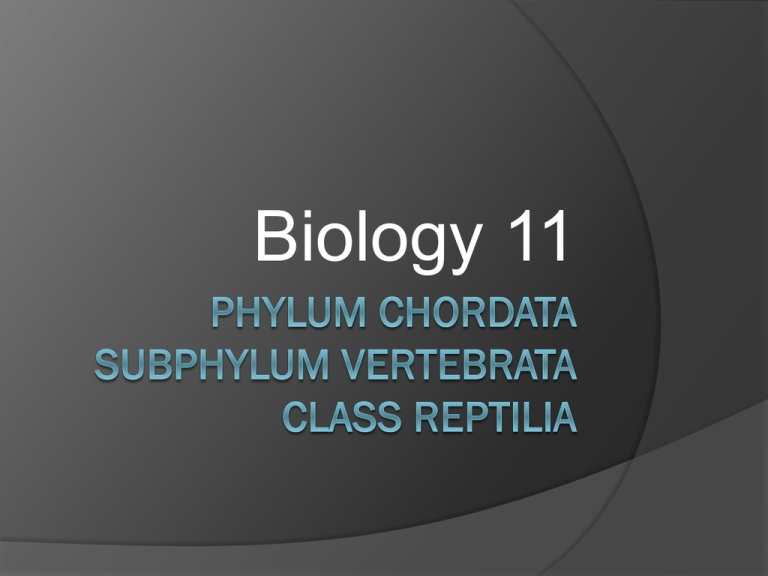
Biology 11
Class Reptilia
Evolved from the amphibians and soon
displaced them
Were much better adapted to land
Reptilia Objectives
General characteristics
Body systems: reproductive, respiratory,
circulatory, nervous and skeletal
4 orders and example animals
General Characteristics
Amniotic egg – shelled
2. Internal fertilization
3. Scales or plates
4. If legs – 2 pair with claws, on ventral surface
5. Well developed lungs
6. Partial division of ventricle
7. Exothermic
1.
Class Reptilia
Characteristics and Advances:
1. Reproduction:
A) The Amniotic Egg: reptiles solved the
problem of water cased development
with the amniotic egg. It allowed them to
take water with them onto land for the
development of the young
B) Internal fertilization was now required
Amniotic egg
Shell – porous, prevents rapid water loss
Chorion – lines shell, gas exchange
Amnion – encloses embryo
Allantois – develops from embryo; carries on
embryonic respiration and excretion
Yolk sac – contains food supply
Class Reptilia
2. Respiratory System:
Improved lungs no longer require skin
for getting O2 - skin can now dry out
Now they can cover skin with scales,
shells or leathery layers
Class Reptilia
3. Circulatory system
Activity levels required more oxygenated
blood - the three and a half chambered
heart
The ventricle was almost completely
separated so that the right side of the
heart pumps to the lungs and the left to
the body
BUT still some mixing!
Class Reptilia
4. Nervous system:
Better senses developing along with a larger
brain, better land adaptation
Cerebrum and cerebellum continue to increase
in size
Class Reptilia
5. Behaviours
Bigger brain and internal fertilization result
in specific behaviors
Mate selection behaviors
Territoriality
This tended to increase contribution of best
fit males to gene pool
Class Reptilia
6. Skeletal
Appendages grow out from ventral side of
reptiles raising their body off the ground not belly draggers
Allows for better and faster movement on
land
Class Reptilia
Evolution
Reptiles reached their evolutionary climax
in the Mesozoic with the dinosaurs.
They were the dominant vertebrate life for
over 200 million years!
Class Reptilia
Evidence suggests that the Mesozoic ended
with a bang - as a large meteorite or comet
struck the Earth
This first brought on intense heat, followed
by at least a ten year global winter
95% of all life went extinct during this very
short time frame including the trilobites
Class Reptilia
However, the Earth was changing anyway
becoming cooler, drier, and more unstable
This favored adaptations that allowed
survival in these conditions
Small isolated pockets of reptiles adapted
and survived the end of the Mesozoic
Modern Day Reptiles
Order Rhynchoephalia: Tuatara (Sphenodon)
Order Chelonia: Turtles
Order Crocodilia: Crocs and gators
Order Squamata: Snakes and lizards
Order Rhynchoephalia
Tuatara (Sphenodon) – only living
example
Found in New Zealand
Resembles large lizard
Parietal eye – third eye covered by skin; senses sun’s
radiation
Order Chelonia
Turtle – sea turtles
230 species
Webbed feet
Soft-shelled
(streamlines)
Omnivorous
Order Chelonia
Terrapin – fresh water turtles
Claws and webbed feet
Symmetrical plates called scutes covering bony under layers
Top shell – carapace
Bottom shell - plastron
Order Chelonia
Tortoise
– land turtle
Long necks, short limbs
Appendages completely drawn into shell, if not – very aggressive
No teeth
Tympanic membrane (poor hearing)
Good sense of smell
Good color vision
Temperature determines sex of eggs: low temp = males
Order Crocodilia
Only reptile with a 4 chambered heart
Carnivorous
Raised nostrils and eyes (so rest of body is underwater)
Valve at back of mouth prevents water from entering lungs
when mouth is open
Order Crocodilia
Alligators
Crocodiles
Less aggressive
More aggressive
More terrestrial
More aquatic
Rectangular head
Triangular head
Teeth not visible when
mouth is closed
Teeth visible when mouth
is closed
Definite vocalizations
No definite vocalizations
Can you tell the difference between
an alligator and a crocodile?
Croc
C
A
Gator
B
Gator
Gator
E
D
Croc
F
Gator
Order Crocodilian
Both Alligators and Crocodiles…
Guard nest and care for young
As with many turtles and some lizards – temperature of nest
determines sex of young
○ Low temperature = females
Order Squamata – Lizards/Snakes
Moveable eyelids
See color (except geckos)
External ear
Vocalize
Live in arid climates, conserve water by excreting uric acid
(white paste that is the pre-cursor to urine)
Lizards
Iguanas – horned toad
True chameleons – change color in response to light,
temperature and mood; arboreal (tree dwelling); tongue longer
than body
Lizards
Gila Monster (aka Beaded Lizard) – only
poisonous lizard known to the world
Native to the desert southwest of the US and Mexico
Poison is found in saliva… no fangs!
The poison is a nerve toxin, that is produced in glands located in the lower jaw. When a
Gila Monster bites an animal, the poison flows into the wound via grooved teeth. This
poison only rarely kills people.
Gila Monster
Beaded Lizard
Lizards
Gecko (Geico?) – most primitive; pads on toes to
cling; makes noises, insectivores, eye has vertical pupil to see
at night
Lizards
Monitor – Komodo Dragon is largest = 10 feet
FYI: The Komodo Dragon is not venomous or poisonous; however, its saliva
contains a number of toxic strains of bacteria which often infect the wounds
inflicted on its prey, causing death.
Snakes
Loss of limbs and external ears
Evolved from lizards
Most numerous reptile
2,800 species (300 poisonous)
Snake Feeding
Carnivorous
Kills via: Poison or constriction
Swallow food whole
Jaw comes unhinged
Elastic ligaments
Glottis moves forward (so can breathe while swallowing)
Large esophagus
No sternum
Strong stomach acid
Snakes
Non-Poisonous:
Garter snake
Black snake
King snake
Boa constrictor
Garter
Poisonous:
Vipers
Rattlesnakes, copperheads, adder
Elapsids (cause swelling of lymph
nodes)
Cobras, coral, kraits
Rattlesnake
Non-Poisonous
Black
Boa
Garter
King
Poisonous Snakes
Cobra
Coral Snake
Copperhead
Rattlesnake
Puff Adder
Krait
Snake Venom
Snake Venom
Neurotoxin – affect nervous system
Hemotoxin or hemmoragin – affects red blood cells
All contain both types, the amounts of each may differ
Danger is in the amount and concentration of injected venom and
where its injected:
In blood vessel… spread fast
In muscle or fat… spread slow
Top Ten Most Deadly Snakes
1) Fierce Snake or Inland Taipan (Oxyuranus microlepidotus),
Australia.
2) Australian Brown Snake (Pseudonaja textilis), Australia.
3) Malayan Krait (Bungarus candidus), Southeast Asia and
Indonesia.
4) Taipan (Oxyuranus scutellatus), Australia.
5) Tiger Snake (Notechis scutatus), Australia..
6) Beaked Sea Snake (Enhydrina schistosa), South Asian waters
Arabian Sea to Coral Sea.
7) Saw Scaled Viper (Echis carinatus), Middle East Asia.
8) Coral Snake (Micrurus fulvius), North America.
9) Boomslang (Dispholidus typus), Africa.
10) Death Adder (Acanthophis antarcticus), Australia and New
Guinea.

